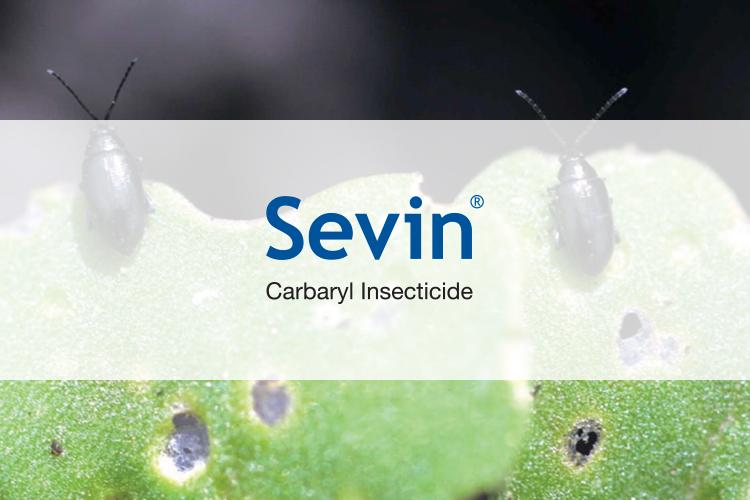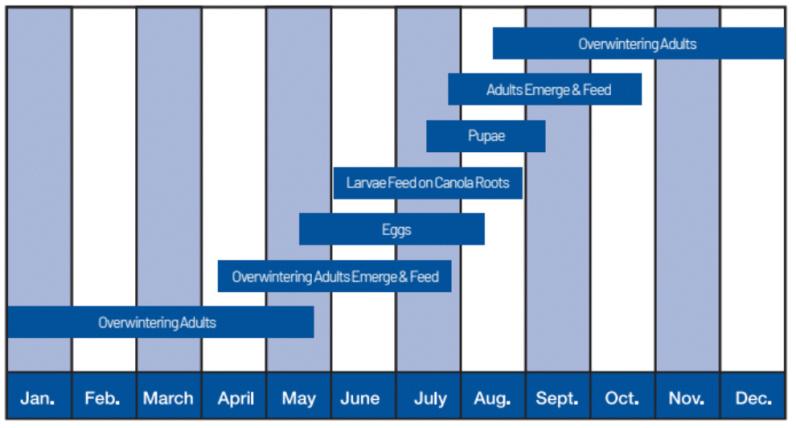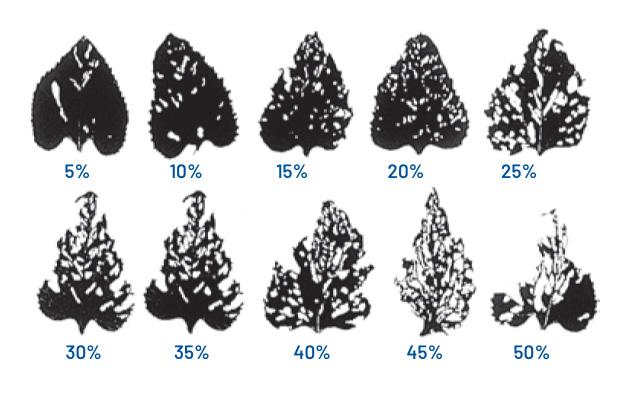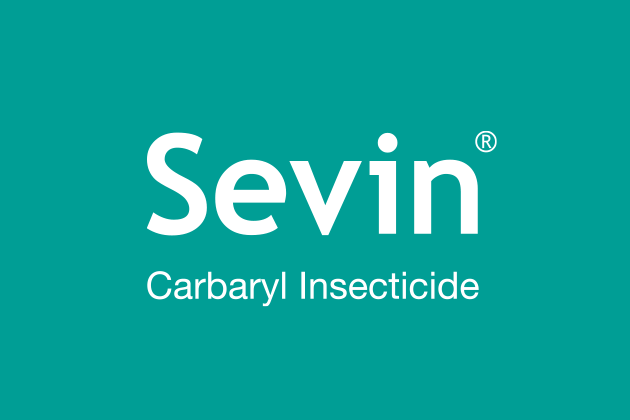Prevent Losses in Canola from Flea Beetle

These Steps Can Mitigate the Risk of Significant Losses in Canola
The flea beetle is the most economically damaging insect pest on canola. However, because its life cycle and feeding patterns are relatively well understood, growers can avoid or minimize the costliest impacts on yield with careful pest management.

Life Cycle of the Flea Beetle
Source: Saskatchewan Agriculture
For growers, the first line of defence is to understand the flea beetle’s life cycle, and the conditions that support flea beetle populations. Agronomic management, discussed on the reverse side, can keep flea beetles largely in check.
Flea beetles overwinter as adults in the leaf litter of shelterbelts, grassy areas, hedges and poplar groves. Within the leaf litter, flea beetle densities may approach 140 to 250 beetles/m2.
Once spring temperatures reach 14°C, adult flea beetles emerge. They initially feed on volunteer canola and weeds such as wild mustard. Once newly planted canola emerges, it becomes the preferred food source, and at the same time, is extremely vulnerable to feeding damage.
Spring feeding occurs from May through June. As adult flea beetles feed on the young seedlings, they cause damage to crop stands. This can delay the plant’s maturity and may lower seed yield. Warm, sunny and dry conditions favor feeding. Cool, wet and windy conditions may confine flea beetles to feeding at a slower pace.
The greatest crop loss occurs when flea beetles feed on the cotyledons and first true leaves two weeks after emergence. As leaf tissue of cotyledons dies around adult flea beetle feeding sites, the leaves take on a shot-hole appearance. Under severe pressure, flea beetles can attack the meristem tissue and kill the plant.
During summer, larvae feed on the secondary root hairs, which may cause minor loss of yield and vigor. The summer generation of adult flea beetles emerges after mid-July and feeds on developing pods. The upper (younger) pods are most affected. Feeding damage may result in poor seed fill, premature pod drying, shrivelled seeds or pod shattering.
Conclusion: It is vital to protect the canola plant during its early stages of development, since this is when most flea beetle damage can occur. Summer feeding should also be closely monitored.

Percentage of leaf damage under normal, moderate and heavy feeding
Agronomic Options for Flea Beetle Defense in Canola
A Balanced Approach to Managing Flea Beetle Risk.
Once the flea beetle’s life cycle and feeding patterns are understood, the canola crop can be managed so as to limit the pest’s damage. Four approaches have been shown to be effective, and depending on prevailing conditions, all should be considered.
1. Early establishment of the canola crop. This is not to be confused with early seeding, which may or may not result in early establishment. The best means to achieve early establishment is to plant certified canola seed in a shallow, firm seed bed. By planting early and shallow, seedlings can grow quickly into larger plants. Larger plants can tolerate more feeding by large populations of flea beetles. Canola planted in wider row spacings of 20-30 cm rather than 10 cm can result in decreased feeding damage per plant as well. Hybrid canola, which emerges from the ground with greater vigor than open-pollinated canola, is an excellent choice when fast emergence is desired.
2. Staggered planting dates. Planting from mid-April to early May can reduce the risk of heat and drought stress on the crop, and help plants recover from flea beetle pressure. It also reduces the risk of an entire canola crop being at its most vulnerable stage during the flea beetle’s intense early feeding.
3. Seed treatment. Seed treatments generally provide up to 21 days of control from emergence, depending on the product and date used. The level and duration of control are closely correlated with the overall flea beetle population. Since flea beetles must ingest the insecticide to be controlled, a very heavy population of flea beetles may not be held in check with seed treatment alone. In choosing a seed treatment, growers should take into account their risk level from flea beetles. They should also closely monitor the crop and apply a post-emergent insecticide where population levels warrant.
4. Foliar insecticide application. Even at low flea beetle levels, feeding damage to canola plants can delay maturity and increase incidence of green and smaller seeds. Minor damage from flea beetle feeding can become irreparable in a matter of days. In newly emerged crops, daily inspection for flea beetles is recommended for at least 14 days. Canola seedlings can withstand 50% leaf loss; however, the economic threshold for control is 25%. After 25%, leaf damage can reach a level where plant development and yield loss are substantially reduced.
Sevin® XLR is considered the most economical flea beetle control product available. Apply to seedling canola plants for up to four weeks after plant emergence. The best control is achieved when the product is applied in the heat of the day, when the insects are actively feeding. For ground-spraying, water volumes should be at least 93.5 l/ha (10 gpa) for the most effective coverage possible, especially in the case of dense foliage or where spray equipment dictates.
Expect control for up to 48 hours after application. To achieve a residual effect, spray must contact foliage directly.


